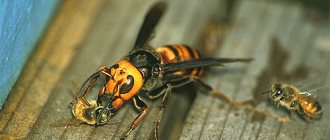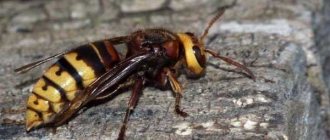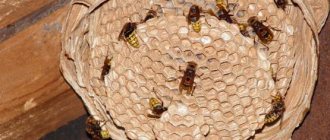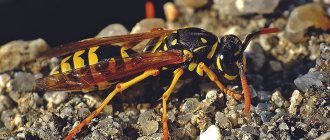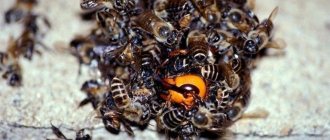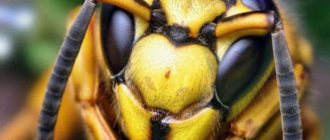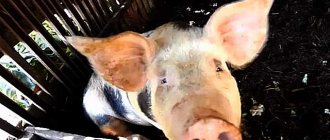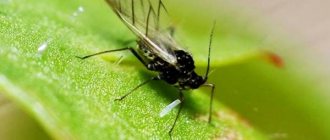Hornets are large wasps that, by their mere appearance, cause fear and an inexplicable feeling of anxiety in most people. It is not surprising, because these insects are predators and amaze with their size - the common hornet reaches 3-3.5 cm, some species - 6 cm in length. In addition, hornet stings are very dangerous to human health - they release twice as much poison in one bite as bees. Since the sting of insects is long and without serrations, they can sting more than once, but until the poison runs out.
Despite these characteristics, it should be understood that hornets are very beneficial insects for the environment. The fact is that adult individuals mainly feed on plant foods: berries, fruits, nectar. Their larvae are fed minced meat from caterpillars, flies, mosquitoes, beetles, spiders and other insects. In just one day, a family of hornets catches almost half a kilogram of pests - this is a fairly significant role in the ecosystem cycle.
Hornets nest
Hornets are rarely aggressive, they do not attack without reason, they are not as annoying as ordinary wasps, and they try to stay away from people. The reason for the attack is most often a threat to the nest or the insect itself.
Important! You should not unreasonably destroy hornet hives - many species of these insects are already at the stage of extinction, some are listed in the Red Book. It is necessary to get rid of hornets only in cases where they pose a danger to human health and quality of life.
What does a hornets nest look like?
Hornets are real architects; their hives amaze with their thoughtfulness, accuracy, and practicality. The shape of a hornet's nest resembles a ball or cone. Its average dimensions are: 30-50 cm – width and 50-70 cm – length. Under optimal conditions, much larger structures can be found - more than a meter. Moreover, the weight of an empty hive rarely exceeds 1 kg.
In its structure, the nest resembles a multi-story building with many rooms and several entrances. In this case, the rooms are honeycombs, the entrances are compartments. The compartments are formed around an axis and separated by a thin partition. Perpendicular to the axis there are floors - tiers along which the uterus moves. They are fastened together by several legs.
One dwelling consists of 3-4 compartments and 7-10 tiers, the whole structure is neat, airy, and can look very impressive.
How to find a hornets nest
Hornets are, at their core, beneficial insects. They do not harm people if left alone. If a hornet hive is found in natural conditions or outside the human habitation area, you should not destroy it or destroy it. In this case, insects are part of the natural environment and fulfill an important role assigned to them.
How to find a nest
How to destroy a hornet nest
As for the hornet family settling near people, you should be careful - this is a rather dangerous neighborhood. Especially if the insects have built a nest in a frequently used or visited place.
The proximity of these giant wasps can be deadly for bees - the hornets attack apiaries, destroy adults and larvae, and eat honey. If even small groups of insect predators regularly appear on a summer cottage or garden plot, it is necessary to start searching for a nest.
Advice. It is very important to start searching and discover the hive in the initial stages of its formation. The queen lays the foundation of the nest - it is she who lays the first tier and lays eggs in the honeycomb. During this period, you can quite easily remove it from the site or destroy it. After a few weeks, the number of young individuals will rapidly increase, and it will be more difficult to get rid of the hive.
Hornets prefer quiet, secluded places, protected from bad weather - this could be a hollow in a tree, a hole in the ground, abandoned buildings, barns, attics.
The search for a nest can be organized as follows:
- Make preparations. An encounter with hornets is quite dangerous for humans. It is very important to prepare properly for it: stock up on antiallergic drugs, wear closed, made of thick material or special protective clothing.
- Start inspecting the premises. Attics, basements, sheds, and outbuildings are carefully examined. Nests are often found in window frames, under the floor and even in the wall. This arrangement is dangerous; it will be very difficult to remove the hornets.
- Conduct an inspection of the entire area. The garden, trees, fallen logs, and stumps are examined. You can take a closer look at the holes in the ground, in particular, under trees.
- Listen. If a visual inspection does not bring results, you can try to hear the hornets - they are quite noisy, especially during the period of nest construction.
- Label the insect. An interesting method that can be used if the search does not produce results. To do this, you need to catch the hornet and mark it with a bright thread or ribbon. Then you can release the insect and carefully monitor the direction of its flight.
Interesting. Contrary to popular belief, hornets do not sleep at night - they are simply less active, but are ready to defend their home.
Having discovered a hornet nest, the degree of danger that insects can bring is determined, depending on their habitat. If the hive is located in a corner where hornets and people do not intersect, it is better not to touch it and let the wasps exist in peace.
If the home is located in a frequently visited place, you will have to get rid of it. This process is quite complex and dangerous, since hornets are always active and aggressive in defense.
The most effective methods for destroying a hive:
- Treat with insecticides.
- Drown.
- Burn.
- Pour boiling water over it.
These methods are tough and quite risky, so it is better to resort to them only in extreme cases.
Prevention of occurrence
Although insects do not return to old nests, they often build new ones not far from them, due to their convenient location and protection from bad weather. To prevent the hornets from settling on the site again, you need to find and burn the old nest. The remaining cellulose and wax must be removed from the surface on which it was kept. Then spray with an insecticide solution to discourage insects from setting up a new home.
To make paper housing, wasps use old wood that has begun to rot, so all branches and stumps must be removed from the area. Repair wooden buildings, cover them with paint and varnish.
You should not leave plant debris or leftover food, especially sweets, on the site, where hornets can take food from. Food waste must be disposed of or kept in closed plastic bags, containers, or bags.
It is known that hornets never build their nest next to the home of another family. Using this feature of wasp behavior, you can hang a dummy nest on the site to repel insects.
The sting of hornets is painful and unpleasant, but they rarely attack people on their own. They attack if they believe that the home is in danger. Therefore, there is no need to destroy a hornet’s nest for no reason. The insects themselves will leave it as soon as the cold weather sets in. In the meantime, you just need to stay away from him, don’t approach or touch him.
How many hornets live in a nest
How to remove hornets from the attic
How many hornets in one nest depends on the comfort of the location of the home and on external factors: weather conditions, availability of food. One family settles into the structure, numbering several hundred adult insects, approximately 400-600 pieces.
Under optimal conditions in a calm, quiet, warm place with large amounts of food, the family becomes strong and produces high-quality offspring in significant numbers. In such cases, the hive reaches a gigantic size - more than a meter in diameter, inhabited by one to two thousand individuals.
Why do you need to get rid of hornets' homes?
To answer the question why it is necessary to destroy hornet nests, you should pay attention to the benefits and harms this large insect brings to humans. Undoubtedly, there is still a certain benefit from Vespa, and it consists in the fact that hornets:
- eat some harmful insects, such as flies, mosquitoes or small locusts;
- occupy holes that could become homes for rodents that cause significant harm to the farm;
- They themselves are food for some species of birds, which in return can eat more useful bumblebees and bees.
This is where the useful aspects of the life of flying corsairs, as representatives of the Vespa genus are often called popularly, end. And if you compare the benefits with the harm that hornets simultaneously cause, it immediately becomes clear why their nests located near human habitation need to be gotten rid of. The harm from these insects is more significant, and it affects both the person himself and the fruits of his activities. It consists in the fact that Vespa:
- pose a real threat to people's health, stinging them very painfully and causing dangerous allergic reactions of the body to the injected poison;
- they destroy bees, often eating out their entire families, and thereby cause material damage to beekeepers;
- They gnaw tree branches and fruits, causing damage to gardening.
How hornets build nests
How to get rid of hornets in the country
One can only be amazed at how hornets build their nest - how much work, discipline, and self-organization is invested in this process. Insects make their homes durable and comfortable. It protects them from heat and cold.
An interesting fact is what hornets make their nests from. The materials for construction are wood and bark. Hornets especially like birch, which is why their nests are lighter than those of other wasps. Pieces of wood are thoroughly chewed, moistened with saliva, and honeycombs, walls, partitions, and shells are gradually molded from the resulting material, ball by ball.
The queen chooses the nest site. She begins to build her future home. First, the queen fashions the first ball of cells in which the eggs are laid. After about a week, the eggs turn into larvae, which, in turn, degenerate into pupae in two weeks. After another two weeks, young worker hornets fly out of the nest and continue to build housing.
How productive the work of the new generation of insects will be depends on how many hornets in the nest will develop throughout the season. After the worker hornets fly out, the eggs of future females and males are laid. They fly out already sexually mature, and immediately after their departure swarming begins.
When the hornets fly away from the nest
By the end of autumn, the hornets' home gradually becomes empty. To figure out when hornets leave their nests, you need to figure out some nuances.
Nest without hornets
Males die almost immediately after swarming. With the onset of cold weather and frost, the working hornets and the queen die. During the same period, fertilized females look for a suitable secluded, warm place for wintering.
With the arrival of autumn, females begin to produce a special substance, which in winter serves as a kind of antifreeze that prevents them from freezing during suspended animation. Trees, hollows, and outbuildings can become temporary homes for hornets. Some individuals may remain over the winter in the old hive.
Only a small percentage of insects survive the cold and thaw. Already with the onset of the first spring warmth, the females leave their shelter and begin to search for a suitable place to found a new hive.
An interesting fact is that hornets do not settle in an old nest - they always build a new house.
Note! Considering the behavior and life cycle of hornets, the optimal periods for removing hives are late autumn and winter. At this time, the nest is empty, there is no risk of insect attack and their return. The nest can be easily removed by sawing off the base and burned.
Hornets are beneficial insects, an indispensable link in the ecosystem. There is no need to thoughtlessly destroy their nests; these insects do not attack without reason. Large wasps become aggressive only when defending themselves and their home. If the hornets begin to build a nest indoors, on the territory of a summer house or personal plot, endangering people's health, you need to try to get rid of it.
3 1 vote
Article rating
Appearance of hornets and the danger of their bites
Hornets are insects that are very similar in appearance to wasps, but have some differences: a larger body size, a brown abdomen. They are useful predators because they feed on various garden pests and their larvae. They also love sweet nectar, vegetable juices of fruits and honey. There are more than 20 species of hornets in the world, many of which are listed in the Red Book.
If large yellow-black wasps often fly into a room, it means that hornets have built their nest nearby.
On a note!
It is completely optional to kill individual individuals: they cannot be frightened or waved at them. It is better to wait until such a “wasp” lands and catch it by covering it with a glass jar. Then take it away and release it into fresh air.
However, you should be aware that having a colony settled nearby can cause a lot of problems due to their ability to protect their home and numerous bites.
The danger from hornets has several unpleasant aspects:
- when defending their home, they can attack a person and inflict numerous bites on him;
- when stinging, hornets are able to remove the sting and bite their offender several times in a row, which is more dangerous to health, since the toxicity of such poison can lead to a severe allergic reaction;
- such insects harm bees by attacking and killing them and destroying their hives.
Important!
For children, pregnant women and people with allergies, numerous hornet stings pose a great danger, as they can cause angioedema, anaphylactic shock and lead to death.
Therefore, in order to get rid of such unpleasant neighbors, you should definitely start looking for hornets in your home, and for this you need to know what the nest looks like and where to look for it.
